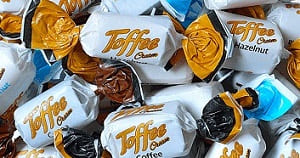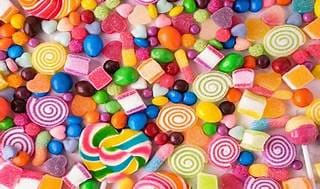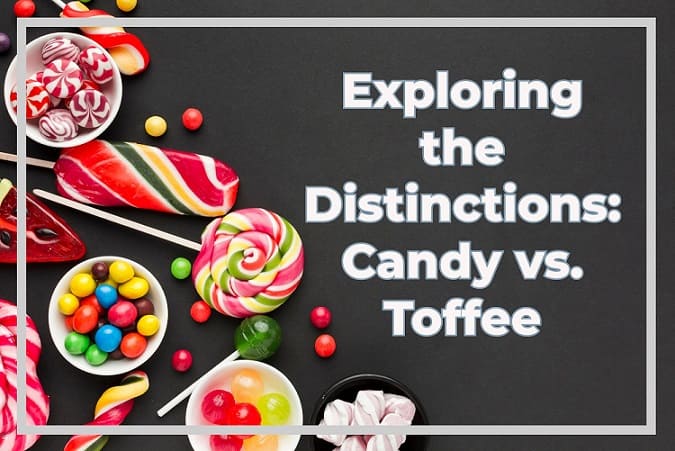![]()
Imagine craving something sweet and being torn between candy and toffee. While candy and toffee are delicious and sometimes used interchangeably, they’re quite different, each with its distinct vibe. So, let’s break down the difference between candy and toffee together. From what makes them tick to their ingredients and more, we uncover it all.
Difference Between Candy and Toffee:
The main difference between toffee and candy is that all toffees and candies, but not all candies are toffees. Toffee is just a part of the candy bandwagon, which also includes chocolates, chewing gums, sugar candies, candied fruit and nuts, sweet cigarettes, and more. Let’s decode the differences, one at a time, but first, definitions.
What is Toffee: Definition

A rich, buttery treat, sweet, chewy, and downright addictive — that’s toffee for you. Think of it as a confection made with caramelizing sugar and butter or cream as the base. Jazz it up with flavorings like vanilla, chocolate, nuts, or even a sprinkle of sea salt to achieve a sweet and savory balance. Almonds, pecans, or cashews might also go into the mix for that crunchy goodness and delectable taste associated with toffees. Some may contain flour. Read More…
-
History & Etymology:
Toffee has its roots in 19th-century England. It was called “Toff,” which came from the word “tough,” thanks to its hard texture. The word toffee made its way into the Oxford English Dictionary only in 1825. But, nobody knows about the word’s origins. For some, it comes from a Creole term for a mix of sugar and molasses, but the details are fuzzy.
-
Trivia:
In the movie Borat, they joke that toffee came from Kazakhstan! How wild is that?
What is Candy: Definition

Any kind of sugary confection, even toffee, is a candy. Think gummy bears, lollipops, chocolate bars, or anything else that satisfies your sweet tooth cravings, candy comes in all shapes, sizes, and flavors. Let’s dive into your top options.
-
History & Etymology:
Back in the late 13th century, “candy” was all about crystallized sugar—think sugary goodness in its purest form. It made its way into English from the Old French term “çucre candi”, which meant “sugar candy”. The root of it all can be traced back to the Arabic word “Qandi”, which came from the Persian “Qand”, meaning “cane sugar.”
Here’s a tidbit: the Persian word “Qand” might come from Sanskrit, where “Khanda” meant “piece (of sugar)”. Some even speculate it traces back to Tamil, where “Kantu” means “candy” and “Kattu” means “to harden, condense.”
Fast forward to the late 19th century in the US, and “candy” wasn’t just about crystallized sugar anymore. Instead, it became this catch-all term for any sweet treat with sugar as its main ingredient. Meanwhile, in Britain, they called these delightful goodies “sweets,” reserving “candy” for those colorful confections made from boiled sugar.
-
Trivia:
Back in 1865, people used to get together for a “candy pull”. They’d whip up some molasses candy and then have a blast pulling and shaping it until it was just right. Talk about a sweet tradition, right?
Related Reads:
| Difference Between Chewing Gum and Bubble Gum | Chappal vs. Slippers: Decoding the Differences |
Difference Between Candy and Toffee: Preparation
Both toffee and candy start with caramelizing sugar, but take different paths from there.
Toffee:
Toffee involves higher temperatures of around 300-310°F / 149-154°C to achieve that satisfying crunch and caramel-like texture. The end product’s quality depends on how well you manage the temperature. Crystallizing and cutting processes follow caramelization.
Candy:
When it comes to candies, it’s like each to their own. Different candies have different recipes and processes. While hard candies are born from boiling sugar syrup to the right temp, soft candies like marshmallows involve extra ingredients and steps. However, common processes include boiling, molding, coating, setting, whipping, aerating, and cutting.
Takeaways:
While both involve caramelizing, toffee requires higher temperatures and precise temperature control for its crunch and texture. On the other hand, candy production spans a variety of methods, from boiling to molding.
Difference Between Candy and Toffee: Ingredients
Both include sugar as the prime base material. But, other ingredients vary vastly.
Toffee:
It is a result of caramelized sugar or molasses with butter and sometimes cream, milk, nuts, and other additions. Some toffees might include flour and a pinch of salt. Here’s a list of common toffee ingredients and their role.
| Ingredients | Role |
| Sugar | The primary sweetener |
| Butter | Provides richness and flavor |
| Salt | Enhances other flavors |
| Milk | Create a creamy texture |
| Chocolate | An extra layer of deliciousness |
| Nuts | Almonds, walnuts, or pecans lend a welcome crunch |
Candy:
The ingredients are type-specific, but candy typically contains sugar and corn syrup for that sweet syrupy goodness. Flavorings like fruit, chocolate, and mint, alongside colorings, and nuts or other add-ins also go into the mix.
| Sugar | The primary sweetener in most candies |
| Water | Combines with sugar to create a syrup |
| Honey | Non-crystallizing honey lends a soft, smooth consistency |
| Molasses | Adds a dark caramel flavor to candies like butterscotch |
| Evaporated Milk | Used in some types of candies |
| Condensed Milk | Often used in fudge and caramel recipes |
| Butter | Adds richness and flavor |
| Vanilla Extract | Commonly used for flavor |
| Spices | Cinnamon, nutmeg, or ginger can enhance taste |
| Chocolate | For chocolate-based candies, such as truffles and the like |
Takeaways:
While sugar is a common ingredient, candies carry more flavorings and add-ins than toffee. Also, milk is a permanent fixture across all toffees, candies often ditch it for water. However, both use flour sparingly, especially hard candies and chocolates.
Difference Between Candy and Toffee: Texture
Given the different preparation methods, texture varies from toffee to candy and even from candy to candy.
Toffee:
Toffee delivers the crunch before melting in your mouth. It’s firm and solid, with a satisfying snap and a smooth, buttery richness melting in your mouth. You can link this to precise temperature control and ingredients.
Candy:
Candies are like a playground of textures. From hard and brittle to soft and chewy, there’s so much to explore. Some candies are smooth and creamy, while others are sticky or even crunchy. Candymakers play with sugar molecules to create different candy textures. Depending on how those sugar crystals stack up, you get either a smooth, melt-in-your-mouth experience or something with a bit more crunch. It’s all about the sugar crystal arrangement!
Takeaways:
Toffee provides a satisfying crunch followed by a smooth, buttery melt-in-your-mouth experience. Meanwhile, candies offer a diverse range of textures, from hard and brittle to soft and chewy, crafted by manipulating sugar molecules.
Difference Between Candy and Toffee: Varieties
One of the major differences between toffee and candy is variety.
Toffee:
Available as English Toffee, Butter Toffee, and Honeycomb Toffee, toffee limits your choices.
- All the rage in the US, English Toffee is buttery with almonds and comes in chewy and hard versions.
- Across the pond in the UK, they’ve got something similar called “butter crunch.”
- In Italy, toffee goes by the name “mou candies.”
Candy:
You are spoilt for choices with options like hard candies, gummies, chocolates, caramels, and more.
| Chocolates | Creamy, rich chocolate candies — whether bars or truffles — are always a hit! |
| Chewing Gum | A chewy delight that comes in all sorts of flavors and keeps your jaws engaged for hours |
| Sugar Candy | Think hard candies, gummies, and all those sugary goodies that satisfy your sweet tooth |
| Candied Fruits & Nuts | Veggies, fruits, or nuts that have been glazed and coated with sugar for extra sweetness |
| Sweet Cigarettes | Candy replicas of cigarettes, typically made of sugar; designed to be chewed. Read More… |
Takeaways:
Since candy is an umbrella term used to describe an array of sugary delights, it offers more variety.
Difference Between Candy and Toffee: Flavors
Toffees offer a more complex, layered flavor profile than your average candy, thanks to natural flavors.
Toffee:
It’s all about rich, buttery goodness with a hint of caramelized sweetness. Toffee makers like to jazz things up with various natural flavors like vanilla, nuts, coffee, and chocolate. Artificial flavorings are used sparingly. Don’t be surprised if you get hints of milk or dark chocolate, the crunchiness of nuts, and a touch of salt to balance it all out.
Candy:
From classic fruit flavors like cherry, orange, and lemon to decadent chocolate and refreshing peppermint, there’s something for every taste bud. Candies do not hold back on artificial colors either. So, whether you’re into bold cherry or a blend of fruity goodness, candy has got you covered with its sweet, sweet flavors.
Difference Between Candy and Toffee: Prices
If you think toffees are cheaper, think again. However, the prices are subject to factors like brand, ingredients, location, and more.
Toffee:
These sweet treats come in different price ranges. Take, for example, a 4-gram Cafe Rio Toffee available for about ₹10 per piece. And if you’re eyeing a 1-kilogram packet, it’ll set you back around ₹459. That’s approximately ₹45.90 per 100 grams.
Candy:
Candies come at various price points. For instance, a pack of Cadbury Gems Chocolate, weighing around 10.68 grams and containing 72 pieces, goes for about ₹310. That’s roughly ₹40.31 per 100 grams. And here’s a fun fact: candy and gum prices went up by 7.5% between September 2022 and September 2023.
Difference Between Candy and Toffee: Usage
The difference between the two also lies in how and when we savor them.
Toffee:
Toffee is a holiday essential, bringing rich, buttery goodness to Thanksgiving tables and special occasions. Its decadent flavor elevates any dessert, impressing both guests and your taste buds!
Candy:
Imagine lounging on the couch, binge-watching your favorite show, and suddenly, you crave something sweet. That’s where candy swoops in to save the day! It’s the go-to for those everyday snacking moments. Plus, candy can rev up your festive celebrations, whether stuffed in stockings, handed out to trick-or-treaters, or hidden inside colorful eggs.
Difference Between Candy and Toffee: Shelf Life
Toffee:
Whether you buy it or make it at home, it can last quite a while. Store-bought toffee can stick around from 2 weeks to a year. If you’re whipping up homemade toffee, you can extend its shelf life by layering it in an airtight container with waxed paper between each layer. Then, pop that container in a cool, dry spot. Freezing can further its shelf life.
Candy:
Most candies stay edible for up to two years, but for optimal taste, aim to enjoy them within 6 months. However, chocolate candies will hang around in the fridge for about 2 weeks and caramels can chill at room temperature for a similar duration. Likewise, popcorn balls stay at peak freshness for a week. Remember, anything with nuts might not last as long.
Difference between Candy and Toffee: Table
| Category | Candy | Toffee |
| Definition | Any sugary confection like toffee, chocolates, gum, hard candies, etc. | A type of candy made by caramelizing sugar and butter |
| Ingredients | Sugar, corn syrup, flavors, colors, nuts, etc. | Sugar, butter, cream, milk, nuts |
| Preparation | Varies based on candy type – boiling, molding, pulling, etc. | Heating sugar and butter to hard crack stage |
| Texture | Variable – chewy, hard, sticky, smooth etc. | Firm, brittle texture with satisfying crunch |
| Varieties | Numerous – chocolates, chewing gum, hard candies etc. | Mainly English, butter, and honeycomb toffee |
| Flavors | Artificial fruit flavors are common along with chocolate, mint, etc. | Caramelized sugar and butter flavor, with natural flavors like nuts, coffee, chocolate |
| Price | Varies widely based on brand, size, etc. | Tends to be more expensive than the average candy |
| Usage | Everyday snacking, treats | Holidays, special occasions |
| Shelf life | Up to 2 years, optimal within 6 months | 2 weeks to 1 year based on storage |
Similarities Between Candy and Toffee:
Now that we have decoded the difference between candy and toffee, let’s look at the similarities.
-
Ingredients:
Both candy and toffee contain sugar or sugar syrups as sweeteners. Plus, both might share other ingredients, such as milk, cream, butter, and nuts like almonds, peanuts, or cashews.
-
Preparation Methods:
Both involve heating sugar syrups to precise temperatures and cutting them into pieces as the final step. Techniques like caramelizing and crystallizing may be common as well.
-
Texture:
Both may be chewy, hard, or brittle and both rely on fats like butter for a smoother mouthfeel.
-
Flavor Profiles:
A sweet, caramelized sugar taste is a common base. The same holds for various flavorings like vanilla, fruit, or chocolate. Both may come with nuts, coconut, or spices for enhanced flavors.
-
Types/Varieties:
Some varieties like caramels, nut brittles, and fudge are both candies and toffees. Even regional favorites like the Indian jaggery candy are toffee.
| Characteristics | Similarities |
| Ingredient | Contain sugar/syrups, milk, cream, butter, and nuts (almonds, peanuts, cashews) |
| Preparation Methods | Involves heating sugar syrups, caramelizing, crystallizing, and cutting |
| Texture | Chewy, hard, or brittle; relies on butter for smoother mouthfeel |
| Flavor Profiles | Sweet, caramelized sugar taste; various flavorings |
| Base Taste | Sweet, caramelized sugar taste |
| Flavorings | Vanilla, fruit, chocolate, and more |
| Enhancements | Nuts (almonds, peanuts, cashews), coconut, spices, and more |
Conclusion:
Despite the overlap, candy and toffee are two different things. We pit the two sugary treats against each other to find out the differences in preparation method, texture, flavor, usage, price, and more. Hope, you understand the difference between candy and toffee by now and appreciate the unique qualities of each treat, whether we’re indulging in the smooth, buttery richness of toffee or enjoying the wide variety of flavors and textures found in candy.
FAQs:
-
What is the main difference between candy and toffee?
All toffees are candies but not all candies are toffees. Toffee is a part of the candy bandwagon, which includes chocolates, gum, hard candies, lollipops, and more. Texture, flavor, price, and preparation methods also vary.
-
How do candy and toffee differ in texture?
Toffee has a firm and solid texture, often with a satisfying crunch followed by a smooth, buttery melt-in-your-mouth experience. On the other hand, candy can vary widely in texture, ranging from hard and brittle to soft and chewy, depending on the specific type of candy being made and the ingredients used.
-
What kind of candy is toffee?
Toffee is a caramelized form of candy. Herein, sugar and butter are heated to a hard crack stage (at least 300 degrees F), left to harden, and formed into the desired shapes upon cooling.
-
What’s the difference between caramel and toffee?
The main difference lies in their ingredients and texture. Caramel is made by heating sugar and water until it reaches a rich golden-brown color, resulting in a smooth and creamy texture with a deep caramelized flavor. Toffee, on the other hand, is made by caramelizing sugar along with butter and sometimes cream, creating a firm and crunchy texture with a rich, buttery taste.
-
Is Phantom Swet Cigarette a candy?
Yes. Phantom Cigarette is a type of sweet cigarette produced and marketed by Harnik Foods. Read More…
Suggested Reading:
- Most Expensive Chewing Gum
- Uncovering the Best Fruit Candy Brands
- Best Jelly Candy Brands: Satiating Sweet Tooth
- The Best Toffee Brands in India: What People Search
- Top 20 Gummy Candy Brands to Try Today
- Which chewing gum do cricketers use?
- Lollipop: History, Types, & the Best Brands in India
- Top Biscuit Brands in 2024: Balancing Health and Taste
- The Best Mint Candy Brands: Ultimate Buying Guide
- Top Noodle Brands in India to Satiate Your Hunger (2024)
Feature Image Courtesy: Freepik
A wordsmith, avid traveler, rationalist, brand loyalist, sports-freak, and an independent researcher, Rohit has authored 18000 writeups for some of the leading online and offline publications in the past 10 years. He digs into information, weaves narratives, and distills complex subjects into engaging content.
